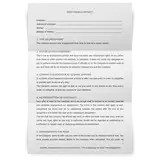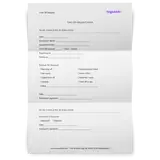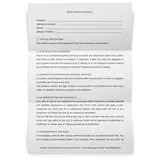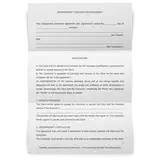First impressions matter - in relationships, job interviews and even employee onboarding.
The first week experience you curate for a new hire sets the tone for their entire time with you. It’s absolutely essential, therefore, to make sure all the finer points of their onboarding are carefully tailored - leaving a bad feeling in a potential employee’s mouth in the first week almost guarantees early turnover.
In keeping with first impressions, the welcome email is usually the first (or one of the first) interaction your employee has with the company as a whole, so it’s crucial to get it right. The first day is always the most overwhelming - a strong welcome email will not only put a new hire’s mind at ease, it’ll form a bedrock for their first week.
There are best practises to writing a fantastic welcome email. This article will dig into a few of them, and give an overall template for effective welcome emails.
Employee Welcome Email
Subject Line
Key to not delivering a terrible subject line: don’t try too hard.
If your goal is to ease your employee in and make them feel comfortable, the last thing you want is some edgy trying-to-be-funny subject line. So, for the love of god, avoid any goofy references from 80s sitcoms when putting together a subject line. Consider the following:
Welcome, [name]! Let’s kick things off.
This subject line is simple and neutral enough it doesn’t feel out of place in a casual environment, nor in a more professional/corporate company. Depending on your company’s vibe and culture you can tweak around it, but it gives an idea - simple, welcoming and upbeat.
Oh - and avoid sounding like a call-to-action. Here’s a big no-no: Action items for Day 1.
If your email sounds like a drill sergeant wrote it, that’s not exactly going to inspire calm in a new hire.
Intro Paragraph
Depending on when this email is sent (whether before joining or to be read on their first day), you want to include start date/times in the intro paragraph as well as office location if it isn’t clear. Beyond that, the intro paragraph should just be a casual way of easing your employee in and welcoming them to the family.
A great way to do this is to include a personalized note tailored to them specifically. For example, consider the following intro paragraph:
We’re so glad you’re joining us! Your experience in QA at [company] and the problem solving you showed in the interviews really stood out - we couldn’t be more excited to have you join and start contributing. We typically start at 9:30 at [address] - if you have any trouble finding your way, just give front desk a call at [number].
By tying in a personal note and referencing what they bring, you accomplish two things:
- you inspire some confidence that you have confidence in their ability to take on the role,
- you show that you genuinely care about them and aren’t just sending them through a cold, artificial and generic onboarding process.
First Day Logistics
After the intro, the main thing you need to include in the email is a clear first day itinerary. First days are hard enough - there’s a firehose of information to gather and people to meet, which makes keeping track of to-do’s extremely difficult.
A simple, clean first-day list of to-dos helps new hires extensively because it gives them a simple roadmap to reference back to through the tumultuous first day. The key is to keep the list simple - just a few simple steps, each with a broad topic as well as a location.
Consider something like the following:
Parking in the building is off the Clair Rd. exit - feel free to park anywhere! Our office plan is pretty simple (you’ll see when you get in), but if you ever get lost just ask Maria at front desk and she’ll be happy to walk you to the destination (as many times as you need - believe me, we’ve all been there).
We try to keep the first day light, so you can ease in and start learning the lay of the land. Here’s a rough schedule you can expect for the day - we’ll let you know in advance if anything changes :)
- 8:30 a.m. – 9 a.m.: Introduction, tour & key fob/company photo (Conf. Room A)
- 9 a.m. – 11 p.m.: Orientation with Rick (Conf Room A)
- 11:30 p.m. – 1 p.m.: Team lunch (location TBD)
- 1:30 p.m. – 2:30 p.m.: Workstation setup and team introductions (Team Desk)
- 3 p.m. – 5 p.m.: Coffee & Sprint Planning (Team Desk)
These times are unlikely to change, but if they do, Rick will let you know. In general, if you’re ever confused about ANYTHING, feel free to email me here, talk to Rick or Maria at front desk - seriously, don’t hesitate with any questions you have. There’s no such thing as dumb questions.
The most important point you can get across in a welcome email is that it’s okay to feel overwhelmed. By reinforcing this during the logistics, you set the stage early that the employee need not feel stupid asking questions. Keeping the logistics extremely simple also helps with this, as employees who don’t feel they’re falling behind are much more likely to proactively clarify points.
Important Set-up Information
You want to keep the welcome email as free of information density as possible. After running through first-day logistics, the next step is to give them all the essential information they’ll need right from the get go - in other words, information that can’t wait a few days to be provided to them.
This includes items like the following:
- Security - If you need special documentation or collateral in order to integrate them with office security, they’ll need this before day 1
- Key Contact - Introduce them to a single key contact who will be their main reference point throughout their onboarding process, before they meet everyone else
- Equipment - Assuming your employee needs their standard equipment from the get go, let them know in advance so they know what to expect
Consider the following as a set-up blurb in your welcome email:
Maria will buzz you in for your first day (you’ll just have to sign something) - after that you can get in with a key fob we’ll be giving you. We’ll be setting you up with our company systems, just fill out the requisition form I’ve attached with your preferences before coming in - we just want to make sure we get you the best tools :)
End it on a positive note
Alright, enough busy messages and work for them to think about - end things casually! Reinforce that they’re welcome and that you fully empathize with the struggles of Day 1. Here’s an example:
And that’s it! If you have ANY questions, again, about this or anything as you get set up, don’t hesitate to ask any of us - seriously. We’re really glad to have you - take your time to ease into things, there’s no rush!
See you Monday.
[Your Signature]
Put altogether, this letter reinforces the employee’s belonging, encourages them to ask questions and empathizes with the stress that comes with a first day - as well as offer just enough information so as not to be overwhelming, but still offering a solid guidebook to navigate the first day.
First days and first weeks are hard enough as it is - nothing builds employee loyalty more than going above and beyond to make their onboarding process as easy, welcoming & happy as possible. Take time to personalize the entire experience - it’s a small price to pay that will end up paying major dividends in the future.
And of course, as with so many things in life - it all starts with an email.
Myth busting: common misconceptions about employee welcome emails
Employee welcome emails are a critical part of the onboarding process, but several misconceptions can lead to ineffective communication. Let's address and clarify five common myths related to employee welcome emails to enhance your understanding of this important HR tool.
Myth 1: employee welcome emails are not important
Clarification: Employee welcome emails are vital for making a positive first impression and helping new employees feel valued and appreciated. They set the tone for your future interactions and can significantly impact employee engagement and retention. A well-crafted welcome message ensures new team members feel integrated into the company culture from day one.
Myth 2: any email subject line will do
Clarification: The email subject line is crucial in determining whether your welcome email will be opened or ignored. A compelling and clear subject line welcome message increases the chances of your email being noticed in a crowded inbox. Using personalized and engaging subject lines can make a significant difference in your open rates and initial engagement with the new employee.
Myth 3: welcome emails should only include a greeting
Clarification: While a warm welcome is essential, your employee welcome email should also provide helpful resources and information that new hires might find useful. This can include customer service contact information, details about their role, popular blog posts relevant to their job, and links to company name policies. Offering valuable content right from the start can enhance the onboarding experience.
Myth 4: one welcome email is enough
Clarification: A single welcome email might not be sufficient to fully engage your new employee. An effective welcome email campaign often involves a series of emails, each providing different types of value, such as introducing the team members, sharing helpful resources, or outlining their first week’s schedule. This approach can keep new hires engaged and informed over a more extended period.
Myth 5: welcome emails will always land in the inbox
Clarification: There’s a common misconception that all welcome emails will automatically be delivered to the inbox. However, they can sometimes end up in the spam folder. To avoid this, ensure that your email templates are well-designed, and the email subject lines are clear and non-spammy. Additionally, including your company's contact details and maintaining a clean email list can help improve deliverability.
By understanding these myths and the facts behind them, you can create more effective employee welcome emails that enhance your email marketing strategy. Utilizing welcome email templates and personalizing your approach can help you connect better with your new employees and achieve better engagement and integration.
![How to write a new employee Welcome Email? [Template] [Example]](/static/image?src=https%3A%2F%2Fcdnblog.unrubble.com%2Fpayload-unrubble-images%2FEmployee-Welcome-Email-Template-600x600.png&width=512&height=512&fit=contain&position=center&quality=65&compressionLevel=9&loop=0&delay=100&crop=null&contentType=image%2Fwebp)




